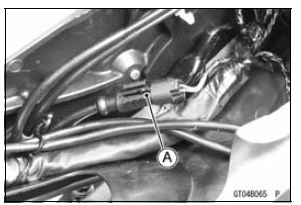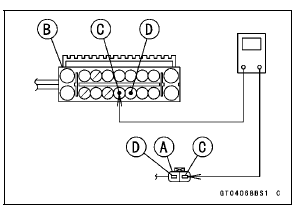


Rear Wheel Rotation Sensor Lead Connector [A] KIBS Hydraulic Unit Lead Connector [B] G Lead Terminals [C] R Lead terminals [D]

If the wiring is open, replace or repair the harness (see KIBS System Circuit in the Brakes chapter).
If the wiring is good, go to next step.
If this service code appears even if all checks are ended, replace the rear wheel rotation sensor (see Rear Wheel Rotation Sensor Removal in the Brakes chapter).
If the service code does not appear, the KIBS system normal (temporary failure).
 Rear Wheel Rotation Sensor Signal Abnormal (Service Code b 44)
Rear Wheel Rotation Sensor Signal Abnormal (Service Code b 44) Power Supply Voltage Inspection (Low-Voltage) (Service Code b 52)
Power Supply Voltage Inspection (Low-Voltage) (Service Code b 52)Brake Disc Warp Inspection
Raise the wheel off the ground with the jack.
Special Tools - Jack: 57001-1238
Jack Attachment: 57001-1608
For front disc inspection, turn the handlebar fully to one
side.
Set up a dial gauge against the disc [A] as shown in
the figure and measure disc runout, while turning [B] the
...
Shift Fork/Gear Groove Wear Inspection
Measure the thickness of the shift fork ears [A], and measure
the width [B] of the gear grooves.
If the thickness of a shift fork ear is less than the service
limit, the shift fork must be replaced.
Shift Fork Ear Thickness
Standard: 5.7 6.0 mm (0.224
0.236 in.)
Service Limit: 5.6 mm ...
Cylinder Head Removal
Remove:
Thermostat Housing (see Thermostat Removal in the
Cooling System chapter)
Exhaust Pipe (see Exhaust Pipe Removal)
Camshafts (see Camshaft Removal)
Heat Insulation Plate [A] (see Engine Removal in the
Engine Removal/Installation chapter)
Place a container under the coolant dr ...